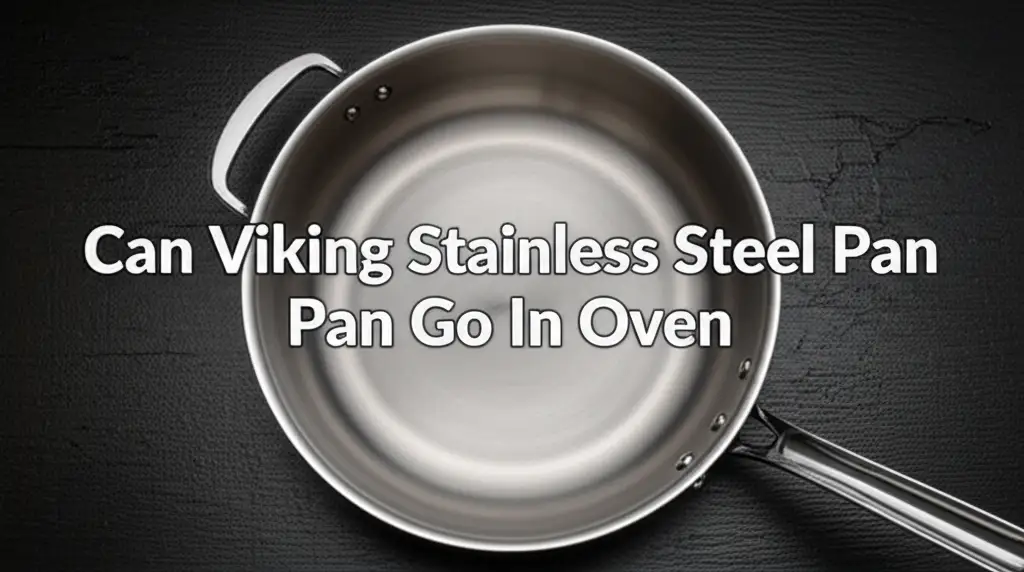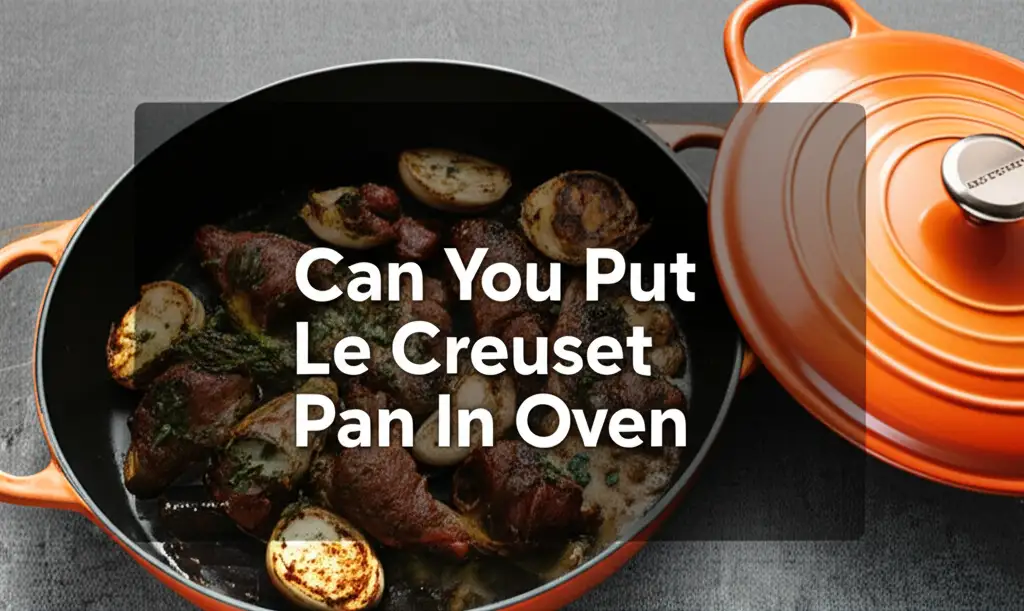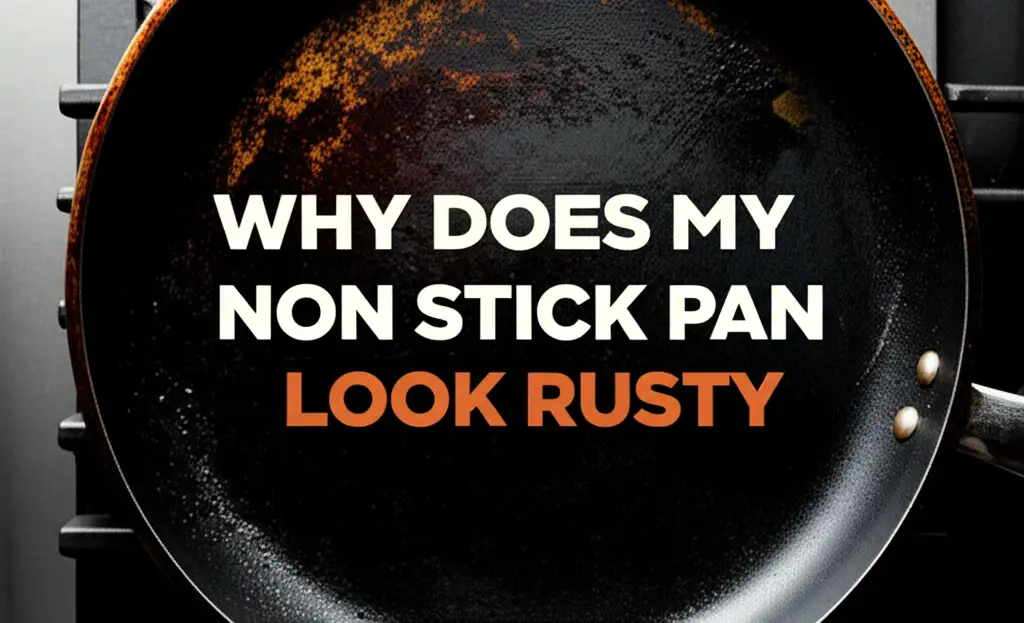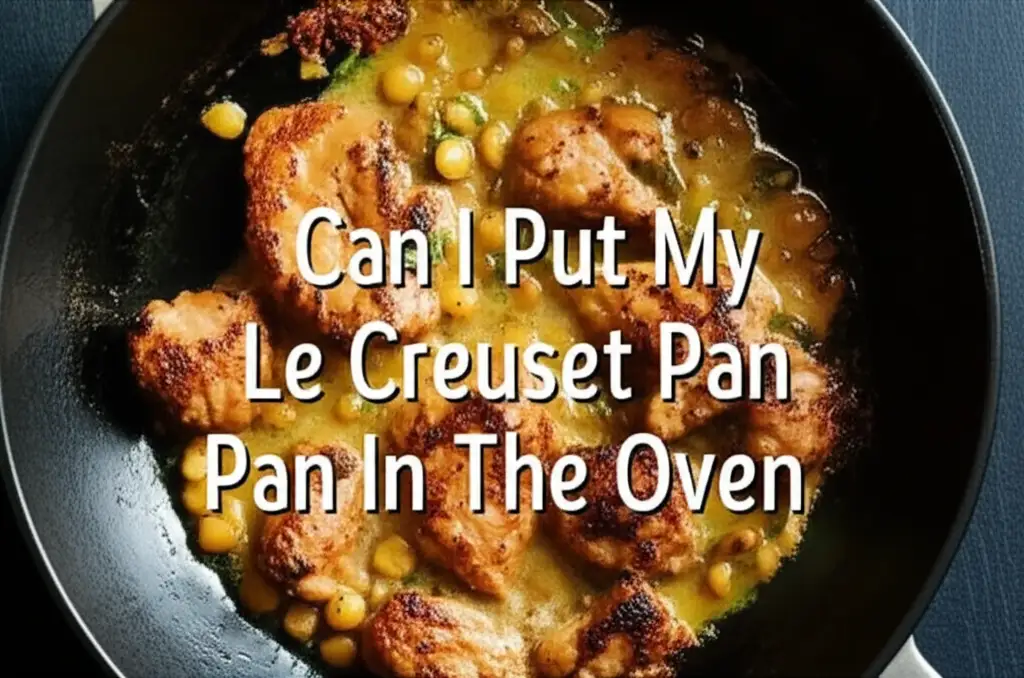· Katria Melrose · Cookware Care · 18 min read
Can Viking Stainless Steel Pan Go In Oven

Viking Stainless Steel Pans: Are They Oven-Safe?
Have you ever wondered if your favorite Viking stainless steel pan can go straight from the stovetop into the oven? Many home cooks appreciate the versatility of stainless steel cookware. It allows for browning meats on the stove and then finishing them in the oven. Viking pans are known for their quality and durability, making them a popular choice. This article explains whether your Viking stainless steel pan is oven-safe. We discuss what to consider before placing it inside a hot oven. You will learn about temperature limits, handle materials, and essential care tips. We aim to help you use your Viking cookware safely and effectively.
Takeaway
- Most Viking stainless steel pans are oven-safe.
- Check the pan’s specific temperature limit, usually stamped on the bottom or packaging.
- Silicone or plastic handles limit oven temperatures; all-metal handles are better for high heat.
- Always use oven mitts when handling hot pans from the oven.
- Proper cleaning and maintenance extend pan life.
Can Viking Stainless Steel Pan Go In Oven?
Yes, most Viking stainless steel pans are designed to be oven-safe. Stainless steel itself tolerates high temperatures well. The oven safety of your specific Viking pan depends mainly on its handle material and construction. Always check the manufacturer’s instructions or the pan’s underside for maximum oven temperature limits to ensure safe use.
Understanding Viking Stainless Steel Oven Compatibility
You likely chose Viking stainless steel cookware for its performance. A common question for cooks is about its oven compatibility. Viking designs many of their stainless steel pans for use both on the stovetop and in the oven. This versatility makes them ideal for various cooking methods, from searing to baking.
The ability of a stainless steel pan to go into the oven relies on its construction. Pure stainless steel can withstand very high temperatures. However, other components of the pan determine its oven safety. These components include the handle material and the pan’s overall design. Always verify the maximum temperature rating for your specific pan model. You can often find this information on the product’s packaging or Viking’s official website. This ensures safe cooking and preserves the quality of your cookware. Many home cooks appreciate the dual-purpose nature of these pans. You can start a dish on the stove and seamlessly transfer it to the oven for finishing. This helps create perfect roasts or casseroles.
The Role of Stainless Steel Material
Stainless steel is an alloy of steel and chromium. This combination makes it resistant to rust and corrosion. It also gives stainless steel excellent heat retention properties. When you consider can my stainless steel pan go in the oven, the material itself is very robust. Stainless steel can handle high temperatures without deforming. This makes it a great choice for oven use.
Viking uses high-quality stainless steel in their cookware. This ensures even heating and durability. The core of the pan, made of stainless steel, is generally oven-safe. This material allows for a wide range of oven cooking. It supports baking, roasting, and broiling. This makes Viking stainless steel pans a versatile kitchen tool.
Handle Materials and Temperature Limits
The handle material is critical for oven safety. Some Viking pans feature all-stainless steel handles. These handles are typically oven-safe to very high temperatures, often up to 600°F (315°C) or even higher. Other Viking models may have handles with silicone or phenolic (plastic) components. These materials have much lower temperature tolerances.
For pans with silicone grips, the oven-safe limit might be around 400°F (204°C). Plastic handles generally have even lower limits. Always check the specific product specifications for your Viking pan. Exceeding these limits can damage the handle. It can also release unpleasant odors or even harmful chemicals. This is why checking the handle material is a vital step. It ensures your pan remains safe and functional in the oven.
Identifying Your Viking Pan’s Oven Safety Rating
You need to know your specific Viking pan’s oven safety rating. This information protects your cookware and ensures safe cooking. Most manufacturers, including Viking, provide clear instructions. You can find this information in several places.
Start by looking at the pan itself. Many pans have the maximum oven temperature stamped on the bottom. If not there, check the original packaging or user manual. These documents contain vital care instructions and temperature limits. If you no longer have these, Viking’s official website is an excellent resource. Navigate to the product page for your specific pan model. They usually list all specifications, including oven compatibility. This step is crucial for safe oven use. It helps you avoid any accidental damage or safety risks.
Checking the Pan’s Underside and Manual
The underside of your Viking stainless steel pan is often the first place to look. Manufacturers frequently emboss or stamp the maximum oven temperature directly onto the metal. Look for symbols that indicate oven safety. You might see a temperature in degrees Fahrenheit or Celsius. If you find no stamping, consult the pan’s manual.
The user manual for your Viking cookware provides detailed information. It includes cleaning instructions and temperature limits for different heat sources. If you purchased a set, the manual covers all pieces. This manual is an important guide for proper care. It ensures your pan lasts for many years. Reviewing these resources helps you understand your pan’s capabilities. It allows you to use your Viking stainless steel pan in the oven confidently.
Consulting Viking’s Official Resources
When in doubt, Viking’s official website is your best resource. Their product pages offer comprehensive details about each cookware line. Search for your specific model number or pan name. You will find specifications like material composition, handle type, and exact oven-safe temperatures. This information is precise and up-to-date.
Customer support on the Viking website can also assist you. You can submit an inquiry if you cannot find the information online. They can provide specific details about your pan’s oven compatibility. Using official resources ensures you receive accurate information. It helps you make informed decisions about cooking with your Viking pan. This is especially useful for older models where packaging might be lost.
Best Practices for Using Your Viking Pan in the Oven
Using your Viking stainless steel pan in the oven offers great cooking flexibility. Following best practices ensures both safety and optimal results. Always preheat your oven to the desired temperature before placing the pan inside. This helps with even cooking. Remember that the pan’s handles will become extremely hot. Always use high-quality oven mitts or heat-resistant gloves when handling the pan.
Avoid sudden temperature changes when moving the pan. Do not take a hot pan from the oven and plunge it into cold water. This can cause thermal shock, leading to warping. Allow the pan to cool naturally before washing. For consistent cooking results, distribute food evenly in the pan. This promotes proper heat circulation and cooking. Adhering to these guidelines helps you get the most from your oven-safe Viking cookware.
Preheat and Temperature Control
Preheating your oven correctly is a fundamental step. It ensures a stable cooking environment for your Viking pan. When you place a cold pan into a hot oven, the pan slowly absorbs heat. This can affect cooking times and food quality. Preheating the pan with the oven often helps the pan reach the correct cooking temperature evenly. This is especially true for searing or roasting.
Maintain the specified temperature. Do not exceed your Viking pan’s maximum oven-safe temperature. Overheating can damage the pan’s finish or handle components. Use an oven thermometer if you suspect your oven’s thermostat is inaccurate. Precise temperature control leads to better cooking outcomes. It also protects your valuable cookware from heat stress.
Using Proper Protection (Oven Mitts)
Safety is paramount when using hot cookware. Stainless steel conducts heat very well. This means the entire pan, including its handles, will become extremely hot in the oven. Always use robust oven mitts or heat-resistant gloves. Standard kitchen towels offer insufficient protection. They can quickly absorb heat and lead to burns.
Keep your oven mitts clean and dry. Wet mitts can transfer heat more quickly. Choose mitts with good insulation and a non-slip grip. This helps you safely maneuver the hot pan. Always place the hot pan on a heat-resistant surface after removing it from the oven. Never place it directly on a countertop or table that could be damaged by heat.
Avoiding Thermal Shock and Warping
Thermal shock occurs when a material experiences a rapid temperature change. For stainless steel pans, this usually happens when a very hot pan meets cold water. If you take a Viking pan directly from a hot oven and run cold water over it, the sudden contraction can cause warping. This warping permanently damages the pan’s flat base. A warped pan will not sit evenly on a stovetop burner. This leads to uneven heating.
Allow your pan to cool down gradually after oven use. Let it sit on a cooling rack or an empty burner until it is warm to the touch. Once it cools, then you can clean it. This simple step prevents irreversible damage to your cookware. It ensures your Viking stainless steel pan maintains its optimal performance. Knowing can you put hot stainless steel pan in water is crucial for pan longevity.
Maintaining Your Viking Stainless Steel Pan After Oven Use
Proper maintenance after oven use ensures your Viking stainless steel pan lasts for years. Cooling down your pan is the first critical step. Never plunge a hot pan into cold water. This prevents thermal shock, which can cause warping. Once the pan is cool, cleaning becomes easier and safer.
Viking stainless steel pans are generally easy to clean. Use warm soapy water and a soft sponge. For stubborn food residues, you can soak the pan for a short period. Avoid abrasive scrubbers or harsh chemicals that can scratch the surface. Regularly inspect your pan for any signs of wear or damage. Proper care keeps your Viking pan performing its best. It helps preserve its aesthetic appeal.
Cooling Down Before Cleaning
As discussed, allowing your Viking pan to cool naturally is essential. Thermal shock can permanently damage the pan’s base. It will no longer sit flat on your stovetop. After removing the pan from the oven, place it on a heat-resistant surface. A wire cooling rack works well. Let it cool for at least 15-30 minutes, or until it is just warm to the touch.
This gradual cooling process prevents stress on the metal. It maintains the pan’s structural integrity. Patience here saves you from potential damage and replacement costs. Once cooled, the pan is ready for safe and effective cleaning. This simple practice preserves the life and performance of your valuable Viking cookware.
Effective Cleaning Techniques
Once your Viking stainless steel pan has cooled, cleaning it is usually straightforward. For everyday cleaning, warm water, dish soap, and a soft sponge are sufficient. Scrub gently to remove food particles. For baked-on food or stubborn stains, you may need a different approach.
You can fill the pan with water and a few drops of dish soap. Bring it to a simmer on the stovetop for 5-10 minutes. This helps loosen stuck-on bits. Then, scrape with a wooden or silicone spatula. For tough residue, baking soda is an excellent natural abrasive. Make a paste with baking soda and water. Apply it to the affected areas, let it sit, then scrub gently. You can also learn how to clean stainless steel more broadly for general maintenance. For severe sticking, exploring how to get your stainless steel pan to not stick can offer further tips. Avoid steel wool pads or harsh cleaners, as they can scratch the stainless steel surface.
Addressing Baked-On Food and Discoloration
Baked-on food can be challenging to remove from your Viking stainless steel pan. Start by soaking the pan in hot soapy water for at least an hour. This softens most residues. If that does not work, try the simmering method described above. Fill the pan with about an inch of water. Add a tablespoon of baking soda and a splash of vinegar. Simmer for 10-15 minutes. The mixture helps lift the stuck-on food.
Discoloration, often appearing as blue or rainbow stains, is common with stainless steel. This happens due to high heat. You can remove these stains with a simple solution of white vinegar. Pour a small amount of vinegar into the pan and swirl it around. Let it sit for a few minutes. Then, wash and rinse. A product specifically designed for stainless steel cleaning can also restore its shine.
Maximizing Versatility: Recipes for Oven-Safe Viking Pans
Your oven-safe Viking stainless steel pan unlocks a world of culinary possibilities. Its ability to go from stovetop to oven makes it incredibly versatile. You can sear meats for a beautiful crust, then finish cooking them gently in the oven. This method is perfect for thicker cuts of steak, chicken, or pork. You can also start a sauce or vegetable sauté on the stove. Then, transfer the pan to the oven for baking or roasting.
Think about one-pan meals. Brown sausages and vegetables on the stove. Then, add a liquid and herbs, and bake until tender. This minimizes cleanup and maximizes flavor. Your Viking pan is also great for baking casseroles or frittatas. Its robust construction ensures even heat distribution, leading to perfectly cooked dishes. Embrace the dual functionality of your Viking stainless steel pan to elevate your cooking.
Seared and Roasted Meats
One of the most popular uses for oven-safe stainless steel pans is searing and roasting meats. Imagine a perfectly seared steak with a crispy crust. You achieve this by first heating your Viking pan on the stovetop until hot. Add a little oil, then sear your steak for a few minutes on each side. The high heat creates a flavorful crust.
After searing, transfer the pan directly to a preheated oven. This allows the meat to cook through gently and evenly. This technique works wonderfully for chicken breasts, pork chops, or even a small roast. The pan helps retain juices and flavors. This method ensures your meat is tender on the inside and beautifully browned on the outside.
One-Pan Dinners and Casseroles
One-pan dinners simplify meal preparation and cleanup. Your Viking stainless steel pan is perfect for this. You can cook proteins and vegetables together in one vessel. Start by browning chicken or sausage on the stovetop. Then, add chopped vegetables like potatoes, carrots, and bell peppers. Toss them with herbs and spices.
Add a liquid like broth or crushed tomatoes. Then, place the entire pan into the oven to bake. This allows all the ingredients to cook together, blending flavors. The result is a delicious, cohesive meal with minimal fuss. Your Viking pan’s even heating ensures everything cooks uniformly. This makes it an ideal tool for busy weeknights or casual gatherings.
Baking and Finishing Dishes
Beyond meats and one-pan meals, your Viking pan is excellent for baking and finishing various dishes. Think about cheesy gratins or bubbling casseroles. You can assemble ingredients directly in the pan. Then, bake them until golden and bubbly. The stainless steel construction helps create a nice crust on the bottom and sides.
It is also great for finishing dishes that started on the stovetop. For instance, you can cook a frittata base on the stove. Then, transfer it to the oven to set and brown the top. This versatility makes your Viking stainless steel pan an indispensable tool. It helps you achieve professional results with ease.
Comparing Viking to Other Oven-Safe Cookware
Viking stainless steel cookware holds a strong reputation for quality. It stands up well against other oven-safe cookware materials. Cast iron, for example, is highly oven-safe and retains heat exceptionally. However, cast iron requires more specific seasoning and care. It is also much heavier than stainless steel.
Ceramic and glass bakeware are oven-safe. They do not work on the stovetop for searing. Non-stick pans often have lower oven-safe temperature limits due to their coating. They are generally less durable at high heat. Viking stainless steel pans offer a balance. They provide excellent searing capabilities on the stovetop. They also offer reliable oven performance without the high maintenance of cast iron. The even heating and durability of Viking stainless steel make it a versatile choice. It often performs better than other materials in dual stovetop-to-oven applications.
Stainless Steel vs. Cast Iron
Stainless steel and cast iron are both popular choices for oven-safe cooking. Cast iron excels at heat retention and delivers a superior sear. It can go into very hot ovens, often up to 500°F (260°C) or higher. However, cast iron is heavy. It also requires seasoning to prevent rust and maintain a non-stick surface. It reacts with acidic foods.
Viking stainless steel pans are lighter and easier to handle. They offer good heat distribution. While they might not retain heat as intensely as cast iron, they are excellent for even cooking. Stainless steel is also non-reactive, meaning it will not leach flavors into acidic foods. It is much easier to clean and maintain than cast iron. For many home cooks, stainless steel offers a more practical and versatile everyday option.
Stainless Steel vs. Non-Stick Cookware
Non-stick cookware is convenient for easy food release. However, its oven safety is often limited. Most non-stick pans have a maximum oven temperature around 350-400°F (175-204°C). Exceeding this limit can damage the non-stick coating. It can also potentially release fumes. Non-stick coatings are also less durable. Metal utensils can scratch them.
Viking stainless steel pans offer superior durability. They can withstand much higher oven temperatures. They do not have a delicate coating to worry about. While stainless steel is not naturally non-stick, with proper technique and preheating, sticking can be minimized. You can learn how to use stainless steel pan for eggs to improve non-stick properties. The robustness of stainless steel makes it a better long-term investment. It is also safer for high-heat oven cooking.
Frequently Asked Questions About Viking Stainless Steel Pans in the Oven
Q1: Can all Viking stainless steel pans go in the oven?
A1: Most Viking stainless steel pans are oven-safe. However, the maximum temperature varies by specific model. Always check for an oven-safe stamp on the pan’s base. You can also consult the product manual or Viking’s official website. Handle materials, like silicone or plastic, will determine the upper temperature limit.
Q2: What is the highest temperature a Viking stainless steel pan can withstand in the oven?
A2: The maximum oven temperature for Viking stainless steel pans typically ranges from 400°F (204°C) to 600°F (315°C). Pans with all-stainless steel handles usually have higher limits. Pans with silicone or phenolic (plastic) components on their handles will have lower maximum temperatures. Always verify your specific pan’s rating.
Q3: How do I know if my Viking pan handle is oven-safe?
A3: Examine your pan’s handle carefully. If it’s made entirely of stainless steel or another metal, it’s likely oven-safe to high temperatures. If it has rubber, silicone, or plastic elements, it has a lower oven-safe limit. These materials can melt or degrade at high temperatures. Check the pan’s manual for specific instructions.
Q4: Can I put a hot Viking stainless steel pan directly into cold water after oven use?
A4: No, you should never place a hot Viking stainless steel pan directly into cold water after oven use. This practice can cause thermal shock. Thermal shock leads to warping of the pan’s base. It will make the pan wobble on your stovetop. Allow the pan to cool completely before cleaning it with water.
Q5: What should I do if my Viking pan discolors after oven use?
A5: Discoloration, often blue or rainbow stains, on stainless steel pans after high-heat oven use is common. You can usually remove these stains. Try cleaning with a mixture of white vinegar and water. Apply the solution, let it sit for a few minutes, then scrub gently. You can also use a specialized stainless steel cleaner to restore its shine.
Conclusion
Understanding if your Viking stainless steel pan can go in the oven is crucial for both cooking versatility and safety. The good news is that most Viking stainless steel pans are indeed designed for oven use. Their robust construction and quality materials make them excellent choices for moving from stovetop to oven. This opens up a world of culinary possibilities for searing, roasting, and baking.
Always remember to check your specific pan’s temperature limits, often found on the base or in the product manual. Pay close attention to handle materials, as silicone or plastic components will limit the maximum oven temperature. By following best practices, such as using oven mitts and allowing pans to cool gradually, you protect your investment and ensure safe, delicious results every time. Embrace the full potential of your Viking stainless steel pan in the oven, and elevate your home cooking experience. Ready to try a new oven-finished recipe? Your Viking pan is likely ready too!





